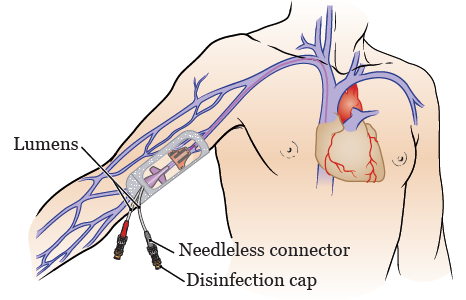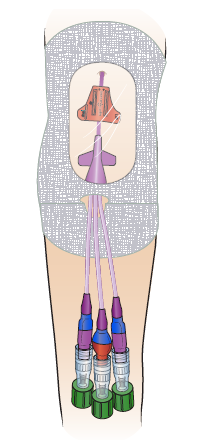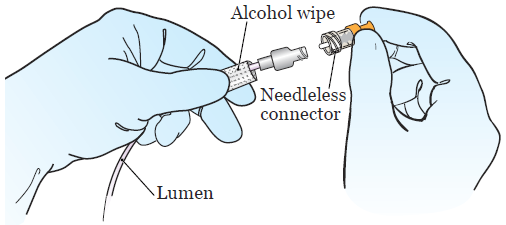Does It Hurt To Have A Picc Line Removed
This information explains what a PICC is and how it'south placed. Information technology also has guidelines for caring for your PICC at home. A PICC is a type of central venous catheter (CVC).
Back to topMost Your PICC
A PICC, also called a PICC line, is a long, flexible catheter (thin tube) that's put into a vein in your upper arm. There are many unlike types of PICCs. Your doctor volition determine which type is best for you lot.
All PICCs have 1 end that goes through a vein in your upper arm upwards to a big vein near your heart. Exterior your body, the PICC divides into one, 2, or 3 smaller tubes chosen lumens. Each lumen has a needleless connector (also called a clave) and a disinfection cap on the cease (run into Figure 1).

Figure ane. Parts of your PICC
A PICC tin can be used to:
- Take blood samples
- Requite fluids
- Give chemotherapy and other medications
- Requite claret transfusions
- Give intravenous (Four) nutrition
Dissimilarity for a computed tomography (CT) scan can exist injected through some PICCs (such as a Bard® Solo Power PICC), merely non all types of PICCs.
Having a PICC can assist you need fewer needle sticks. A PICC can stay in your torso for your entire handling, upward to 18 months. Your doctor volition remove it when you practise non need it anymore.
Having a PICC should not keep yous from doing your normal activities, such as piece of work, school, sexual activity, showering, and mild exercise. Avoid contact sports, such as football and soccer, while your PICC is in place. Ask your doc or nurse near whatsoever activities earlier you start them.
You lot'll have a procedure to place your PICC. Your nurse will tell y'all how to get fix for your procedure. They'll also teach you how to treat your PICC after your process. Yous can have a caregiver, family unit member, or friend learn with y'all.
Back to topBefore Your Process
Inquire about your medications
Y'all might demand to cease taking some of your medications before your procedure. Talk with your doctor most which medications are safe for you to stop taking. We've included some common examples below.
Anticoagulants (claret thinners)
If you take a blood thinner (medication that affects the fashion your blood clots), ask the doctor doing your process what to do. Their contact information is listed at the stop of this resources. Whether they recommend y'all stop taking the medication depends on the reason you're taking it.
Examples of blood thinners include:
|
|
Exercise not stop taking your blood thinner medication without talking with a fellow member of your intendance team.
Please read the resource Common Medications Containing Aspirin, Other Nonsteroidal Anti-inflammatory Drugs (NSAIDs), or Vitamin E. It has important information about medications you lot'll need to avert before your procedure and what medications you can accept instead. Yous can find it online or ask your healthcare provider for a copy.
Remove devices from your skin
If y'all wear any of the following devices on your skin, the manufacturer recommends you remove it earlier your scan or procedure:
- Continuous glucose monitor (CGM)
- Insulin pump
Talk with your healthcare provider virtually scheduling your engagement closer to the date yous demand to change your device. Make sure you have an actress device with you to put on after your browse or procedure.
If yous're not sure how to manage your glucose while your device is off, talk with the healthcare provider who manages your diabetes intendance before your appointment.
Tell usa if you're sick
If you get ill (such as a fever, cold, sore pharynx, or the flu) before your procedure, call your doctor's office.
Back to topThe Twenty-four hour period of Your Procedure
Things to remember
- Take only the medications your physician told yous to take the morning of your procedure. Take them with a few sips of h2o.
- Practice not apply cream (thick moisturizers) or petroleum jelly (Vaseline®).
What to expect
One time you arrive at the hospital, doctors, nurses, and other staff members will ask y'all to say and spell your name and date of birth many times. This is for your safety. People with the aforementioned or a similar name may be having a process on the same mean solar day.
Dorsum to peakDuring Your Procedure

Figure ii. PICC with SecurAcath and Tegaderm
Your PICC volition be put in past a doctor or nurse. First, you'll get a numbing injection (shot) where your PICC volition be placed. You will not need general anesthesia (medication to make you slumber).
One time the area is numb, the doc or nurse volition make a small incision (surgical cut) in your upper arm. They'll identify the PICC into a vein in your arm and gently motility the end of the PICC into a vein near your heart (see Figure 1). They'll use an imaging scan to assistance them encounter the catheter while they practice this.
Once the PICC is in the right place, the doctor will put a SecurAcath® over the part that'southward outside your body to go along information technology from moving (see Figure 2). The SecurAcath volition stay in place the whole time you accept the PICC. They'll also put a Tegaderm™ dressing over your PICC go out site (the place where it leaves your body) to keep information technology clean. The Tegaderm dressing will be changed regularly.
Back to topAfter Your Procedure
After your process, yous'll be monitored until you're ready to move to your hospital room or exist discharged from the hospital.
You might have some bleeding and mild discomfort at your catheter go out side. This tin can last for nearly 1 to 3 days after your PICC is placed. If y'all have any bleeding from your leave site, apply pressure and a cold compress to the area. Call your dr. or nurse if the bleeding and discomfort gets worse at whatsoever time.
Practice non shower for 24 hours later your procedure.
Your emergency kit
Your nurse volition requite you lot an emergency kit before your process or before yous're discharged from the hospital. The emergency kit has:
- one toothless clamp
- 1 dressing change kit. The kit includes:
- 2 face masks
- Booze-based (Purell®) hand wipe
- Disposable drape
- 2 pairs of nitrile gloves (sterile gloves)
- Chloroprep® applicator
- Alcohol pads
- No Sting swab stick
- 3 needless connectors
- Tegaderm CHG dressing
- Disinfection caps
- Your doctor'due south office and emergency telephone numbers.
Go along your emergency kit with you at all times. You'll need information technology if your PICC is leaking, your Tegaderm dressing is damaged or comes off, or your needleless connector or disinfection cap falls off.
Back to topCaring for Your PICC at Home
- Enquire your nurse about the best way to secure your catheter.
- Practise non put tape over the connexion site (where the needleless connector connects to the lumens).
- Check your leave site every day for:
- Redness
- Tenderness
- Leakage
- Swelling
- Bleeding
- Do not have whatever of the post-obit on the arm where your PICC was placed:
- Needle sticks (such equally for blood draws or an Four line)
- Blood pressure measurements
- Tight clothing or tourniquets
- Your Tegaderm dressing, needleless connectors, and disinfection caps will need to be changed and your PICC will need to exist flushed at least in one case a week. It'southward best if you tin come to a Memorial Sloan Kettering (MSK) location so a nurse can intendance for your PICC. If you cannot come up to an MSK site, your nurse volition assistance you brand other arrangements. Always contact your dr. or nurse if you lot have any questions.
What to do if your PICC is leaking
- Clamp your PICC line above the leak. Use the clamp in your emergency kit.
- Wipe the area that's leaking with an alcohol pad.
- Call your doctor or nurse right abroad.
If fluid is leaking while you lot're getting an infusion, check that the needleless connector is on tightly. If information technology'southward yet leaking, call your doctor or nurse right abroad.
If you're getting an infusion at home and fluid is leaking from your exit site, turn off the infusion. Call your doctor or nurse right away.
What to practice if your Tegaderm dressing is damaged, loose, or muddy
- Do non take off the damaged, loose, or dirty dressing. Put a new Tegaderm dressing over it.
- Call your doctor or nurse right away.
What to exercise if your Tegaderm dressing is moisture
- Do not take off the wet Tegaderm dressing. Do not put another dressing over it.
- Phone call your doctor or nurse right away.
What to do if your disinfection cap falls off
Throw the disinfection cap that brutal off in the trash. Practise not put it dorsum on the lumen.
To put on a new disinfection cap:
- Clean your hands with soap and h2o or an alcohol-based hand sanitizer.
- Get a new disinfection cap from your emergency kit. Remove the cap from the strip.
- Hold the needleless connector in one mitt. With your other hand, gently push and twist the new disinfection cap onto the end of the needleless connector.
What to practice if your needleless connector falls off
Throw the needleless connector that roughshod off in the trash. Do not put it back on the lumen.
To put on a new needleless connector:
- Gather your supplies. You'll need:
- one pair of nonsterile gloves
- 2 alcohol pads
- 1 new needleless connector
- 1 new disinfection cap
- Make clean your hands with soap and water or an alcohol-based hand sanitizer. Put the gloves on.
- Get your supplies ready.
- Open ane of the booze pad packets, just leave the booze pad within.
- Open the needleless connector packet, only get out the needleless connector inside.
- Pull the tab to take the cover off the disinfection cap, merely exit the disinfection cap inside its plastic holder.
- Open the other booze pad packet. Using the booze pad inside, option up the lumen with your nondominant mitt (the manus you do non write with). Hold it close to the end (run into Figure 3).

Figure 3. Twisting on the new needleless connector
- Selection up the other, open alcohol pad with your dominant mitt (the hand yous write with). Scrub the open end of the lumen with the booze pad for 15 seconds, and then throw the alcohol pad in the trash. Let the lumen dry for xv seconds. Keep holding it with the booze pad in your nondominant hand.
- Choice up the new needleless connector with your gratis hand. If it has a cover, take the cover off. You lot can practice this using the knuckles of your other hand. Then, twist the new needleless connector onto the cease of the lumen (see Figure iii). Proceed property the lumen with the alcohol pad in your nondominant mitt.
- Selection up the plastic holder with the disinfection cap with your gratuitous hand. Gently push and twist the disinfection cap onto the end of the needleless connector. Once information technology's fastened, pull off the plastic holder and throw it away.
- Take your gloves off. Make clean your hands.
Telephone call your doctor or nurse after you change the needleless connector.
Back to pinnacleGuidelines for Showering
Follow the instructions in this department when you shower. Do not submerge your PICC in water (such as in a bathtub or swimming puddle).
For more than information near showering with a PICC, spotter Showering While You lot Have a Key Venous Catheter (CVC).
Employ a waterproof cover
You tin shower with your PICC in place using a one-fourth dimension-use waterproof cover (such as Aquaguard®) that goes over your dressing to proceed information technology from getting moisture. You can buy waterproof covers online.
Each time you shower, cover your Tegaderm dressing completely with a new waterproof cover. To put on the cover:
- Peel off the top and side strips.
- Place the pinnacle border above your dressing. Do non let the tape on the waterproof cover touch your Tegaderm dressing. It can elevator your dressing when you remove the waterproof embrace after showering. Smooth the cover down over your dressing.
- Skin off the bottom strip. Brand sure the bottom edge of the waterproof encompass is below your dressing and the lumens of your PICC are tucked into the waterproof comprehend and completely covered. Smooth the lesser edge down.
Practice not shower for longer than 15 minutes. Employ warm water, not hot h2o. This will help keep the waterproof comprehend from coming off.
After your shower, dry the waterproof comprehend before removing it.
Use a 4% chlorhexidine gluconate (CHG) solution antiseptic peel cleanser (such as Hibiclens®)
While your PICC is in identify, it's very of import to keep your skin clean to lower your risk of infection. Launder with a four% CHG solution antiseptic skin cleanser every day while your PICC is in place.
An antiseptic is something that kills bacteria and other germs. 4% CHG solution is an antiseptic that kills germs for upwardly to 24 hours after you utilise it. Showering with a 4% CHG solution will help lower your risk of infection.
You tin can buy a 4% CHG solution antiseptic skin cleanser from any local chemist's or online. A staff member will also give you a small bottle when you lot're discharged from the hospital.
Instructions for using a iv% CHG solution antiseptic skin cleanser
- Use your normal shampoo to wash your hair. Rinse your head well.
- Use your normal lather to wash your face up and genital area. Rinse your body well with warm water.
- Open the 4% CHG solution canteen. Pour some into your hand or a clean washcloth.
- Motility away from the shower stream. Rub the four% CHG solution gently over your torso from your neck to your anxiety. Don't put it on your face or genital area.
- Motion back into the shower stream to rinse off the four% CHG solution. Utilize warm water.
- Dry out yourself off with a clean towel after your shower.
- Don't put on any lotion, cream, deodorant, makeup, pulverization, perfume, or cologne after your shower.
Important points to remember when using 4% CHG solution
- Do not employ regular lather, lotion, cream, powder, or deodorant without talking with your nurse first. If you're in the hospital, your nurse might give yous a lotion that yous tin utilise afterward using 4% CHG solution.
- Practice non utilize 4% CHG solution on your head, face up, ears, eyes, oral fissure, genital area, or on deep wounds. If you take a wound and are not sure if you should use 4% CHG solution on it, ask your md or nurse.
- Do not use four% CHG solution if you're allergic to chlorhexidine.
- If your skin gets irritated or you have an allergic reaction when using 4% CHG solution, stop using information technology. Telephone call your doctor.
When to Call Your Healthcare Provider
Call your healthcare provider correct away if:
- You pull your PICC line out of identify or remember you might take pulled information technology out of identify.
- Yous have a fever of 100.4 °F (38 °C) or higher.
- You have shortness of breath.
- You lot experience lightheaded or dizzy.
- You have nausea (feeling like you're going to throw up) or airsickness (throwing upwardly).
- Y'all feel confused.
- You take discomfort in your chest.
- You have swelling in your mitt, fingers, upper arm, or neck.
- Yous have agonized in the arm where your PICC is placed.
- You have heart palpitations (a faster heartbeat than usual).
- Yous have numbness or tingling in your arm, hands, or fingers of the arm where the PICC line is placed.
- You accept haemorrhage from the PICC line site.
- Y'all accept redness or warmth at the PICC line site or in the arm with the PICC line.
- Your PICC line is leaking.
Does It Hurt To Have A Picc Line Removed,
Source: https://www.mskcc.org/cancer-care/patient-education/about-your-peripherally-inserted-central-catheter-picc
Posted by: martinezwitow1947.blogspot.com


0 Response to "Does It Hurt To Have A Picc Line Removed"
Post a Comment